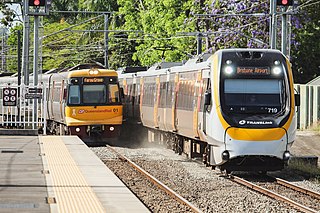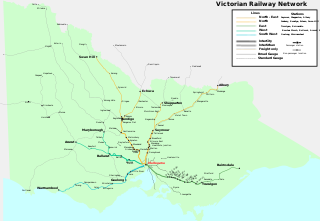List of current stations
| Station | Served by | Distance from Adelaide | Date opened | Previous name(s) | Transport connections |
|---|---|---|---|---|---|
| Adelaide | 0.00 km (0 mi) | 19 April 1856 | |||
| Adelaide Showground | 4.00 km (2.49 mi) | 17 February 2014 | |||
| Albert Park | Grange | 9.10 km (5.65 mi) | 1882 | | |
| Alberton | Outer Harbor | 10.20 km (6.34 mi) | 1856 | ||
| Ascot Park | Seaford | 10.20 km (6.34 mi) | 1914 | ||
| Belair | Belair | 21.50 km (13.36 mi) | 1883 | ||
| Blackwood | 18.10 km (11.25 mi) | | |||
| Bowden | 2.70 km (1.68 mi) | 1856 (original site) 15 January 2018 (present site) | |||
| Brighton | Seaford | 16.00 km (9.94 mi) | 1913 (original site) 25 January 1976 (present site) | | |
| Broadmeadows | Gawler | 28.20 km (17.52 mi) | c. 1950 | Elizabeth North (c.1950–1961) | |
| Cheltenham | Outer Harbor | 9.20 km (5.72 mi) | 1959 | ||
| Chidda | Gawler | 18.60 km (11.56 mi) | n.d. | ||
| Christie Downs | Seaford | 28.90 km (17.96 mi) | 25 January 1976 (original site) November 1981 (present site) | | |
| Clarence Park | 6.30 km (3.91 mi) | 1913 | |||
| Coromandel | Belair | 17.20 km (10.69 mi) | 1883 | ||
| Croydon | 4.20 km (2.61 mi) | 1888 | |||
| Draper | Outer Harbor | 17.20 km (10.69 mi) | n.d. | | |
| Dry Creek | Gawler | 10.60 km (6.59 mi) | 1856 | ||
| Dudley Park | 4.90 km (3.04 mi) | 1915 | |||
| East Grange | Grange | 12.00 km (7.46 mi) | n.d. | ||
| Eden Hills | Belair | 14.20 km (8.82 mi) | 1 April 1912 | ||
| Edwardstown | 7.90 km (4.91 mi) | n.d. | |||
| Elizabeth | Gawler | 25.80 km (16.03 mi) | 1960 | ||
| Elizabeth South | 24.00 km (14.91 mi) | n.d. | |||
| Emerson | 7.10 km (4.41 mi) | 16 July 1928 | |||
| Ethelton | Outer Harbor | 13.10 km (8.14 mi) | 1916 | ||
| Evanston | Gawler | 38.30 km (23.80 mi) | n.d. | ||
| Flinders | Flinders | 13.65 km (8.48 mi) | 29 December 2020 | | |
| Gawler | Gawler | 39.80 km (24.73 mi) | 1857 | | |
| Gawler Central | 42.20 km (26.22 mi) | May 1911 | Willaston (May–Sept 1911) North Gawler (1911–1984) | ||
| Gawler Oval | 41.40 km (25.72 mi) | n.d. | |||
| Gawler Racecourse (limited services) | 39.30 km (24.42 mi) | 1913 | |||
| Glanville | Outer Harbor | 13.80 km (8.57 mi) | 1878 | | |
| Glenalta | Belair | 19.30 km (11.99 mi) | n.d. | Belair Road (n.d.) | |
| Goodwood | 5.00 km (3.11 mi) | 5 March 1883 | |||
| Grange | Grange | 13.00 km (8.08 mi) | 1882 (original site) 9 March 1986 (present site) | | |
| Greenfields | Gawler | 15.50 km (9.63 mi) | 1969 | Green Fields (n.d.) | |
| Hallett Cove | Seaford | 21.40 km (13.30 mi) | 1915 (original site) c. 1970 (present site) | Hallett's Cove (1911–1969) | |
| Hallett Cove Beach | 22.90 km (14.23 mi) | 30 June 1974 | |||
| Hove | 14.60 km (9.07 mi) | 12 January 1914 | North Brighton (Jan–Apr 1914) Middle Brighton (1914–1920) | ||
| Islington | Gawler | 6.00 km (3.73 mi) | n.d. | ||
| Kilburn | 7.70 km (4.78 mi) | 1915 | |||
| Kilkenny | 6.00 km (3.73 mi) | 1881 | | ||
| Kudla | Gawler | 34.10 km (21.19 mi) | 1959 | ||
| Largs | Outer Harbor | 15.50 km (9.63 mi) | 1907 | | |
| Largs North | 16.40 km (10.19 mi) | 21 August 1916 | Swansea (1916–1945) | ||
| Lonsdale | Seaford | 26.70 km (16.59 mi) | 1976 | ||
| Lynton | Belair | 10.70 km (6.65 mi) | c. 1950 | ||
| Marino | Seaford | 18.30 km (11.37 mi) | 1913 | | |
| Marino Rocks | 18.90 km (11.74 mi) | 1915 | |||
| Marion | 11.40 km (7.08 mi) | 26 May 1954 | |||
| Mawson Lakes | Gawler | 14.30 km (8.89 mi) | 26 February 2006 | ||
| Midlunga | Outer Harbor | 18.80 km (11.68 mi) | 1921 | | |
| Mile End | 2.00 km (1.24 mi) | 1898 | |||
| Millswood | Belair | 5.90 km (3.67 mi) | c. 1910 28 April 1995 (closed) 12 October 2014 (re-opened) | ||
| Mitcham | 8.50 km (5.28 mi) | March 1883 | | ||
| Mitchell Park | Flinders | 11.50 km (7.15 mi) | 1 July 1966 | ||
| Munno Para | Gawler | 32.00 km (19.88 mi) | 1978 (original site) March 2012 (present site) | | |
| Noarlunga Centre | Seaford | 30.20 km (18.77 mi) | 2 April 1978 | ||
| North Adelaide | Gawler | 2.50 km (1.55 mi) | 1857 | ||
| North Haven | Outer Harbor | 20.50 km (12.74 mi) | 13 September 1981 | ||
| Nurlutta | Gawler | 21.50 km (13.36 mi) | 1950 | ||
| Oaklands | Seaford | 13.00 km (8.08 mi) | 1913 (original site) 10 June 2008 (present site) | | |
| Osborne | Outer Harbor | 19.60 km (12.18 mi) | 30 November 1908 | ||
| Outer Harbor | 21.90 km (13.61 mi) | 1907 (original site) 1926 (present site) | |||
| Ovingham | Gawler | 3.60 km (2.24 mi) | c. 1880 | ||
| Parafield | 17.70 km (11.00 mi) | 1928 | |||
| Parafield Gardens | 16.60 km (10.31 mi) | 1 May 1968 | |||
| Peterhead | Outer Harbor | 14.60 km (9.07 mi) | 1911 | ||
| Pinera | Belair | 20.20 km (12.55 mi) | c. 1920 | Overway Bridge (c.1920–c.1950) | |
| Port Adelaide | Outer Harbor | 11.70 km (7.27 mi) | 1916 | Commercial Road (1916–1981) | |
| Port Dock (under re-construction) | 18.10 km (11.25 mi) | April 1856 13 September 1981 (closed) 2024 (re-opening) | Port Adelaide (1856–1916) | ||
| Salisbury | Gawler | 20.20 km (12.55 mi) | June 1857 | ||
| Seacliff | Seaford | 17.00 km (10.56 mi) | 1915 | | |
| Seaford | 35.90 km (22.31 mi) | 23 February 2014 | |||
| Seaford Meadows | 34.70 km (21.56 mi) | | |||
| Seaton Park | Grange | 10.30 km (6.40 mi) | n.d. | | |
| Smithfield | Gawler | 30.20 km (18.77 mi) | 1857 | ||
| St Clair | Outer Harbor | 8.60 km (5.34 mi) | 23 February 2014 | | |
| Tambelin | Gawler | 37.40 km (23.24 mi) | n.d. (original site) 1986 (present site) | ||
| Taperoo | Outer Harbor | 18.20 km (11.31 mi) | n.d. | Silicate Siding (n.d.–1920) | |
| Torrens Park | Belair | 9.30 km (5.78 mi) | n.d. | Blythwood (n.d.–1921) | |
| Tonsley | Flinders | 12.20 km (7.58 mi) | 1 July 1966 (original site) 29 December 2020 (present site) | ||
| Unley Park | Belair | 7.00 km (4.35 mi) | c. 1910 | | |
| Warradale | Seaford | 13.70 km (8.51 mi) | 1956 | ||
| West Croydon | 5.10 km (3.17 mi) | 21 December 1915 | |||
| Womma | Gawler | 27.30 km (16.96 mi) | c. 1950 | | |
| Woodlands Park | 9.10 km (5.65 mi) | 1925 | |||
| Woodville | 7.50 km (4.66 mi) | April 1856 | |||
| Woodville Park | 6.80 km (4.23 mi) | December 1936 |
















